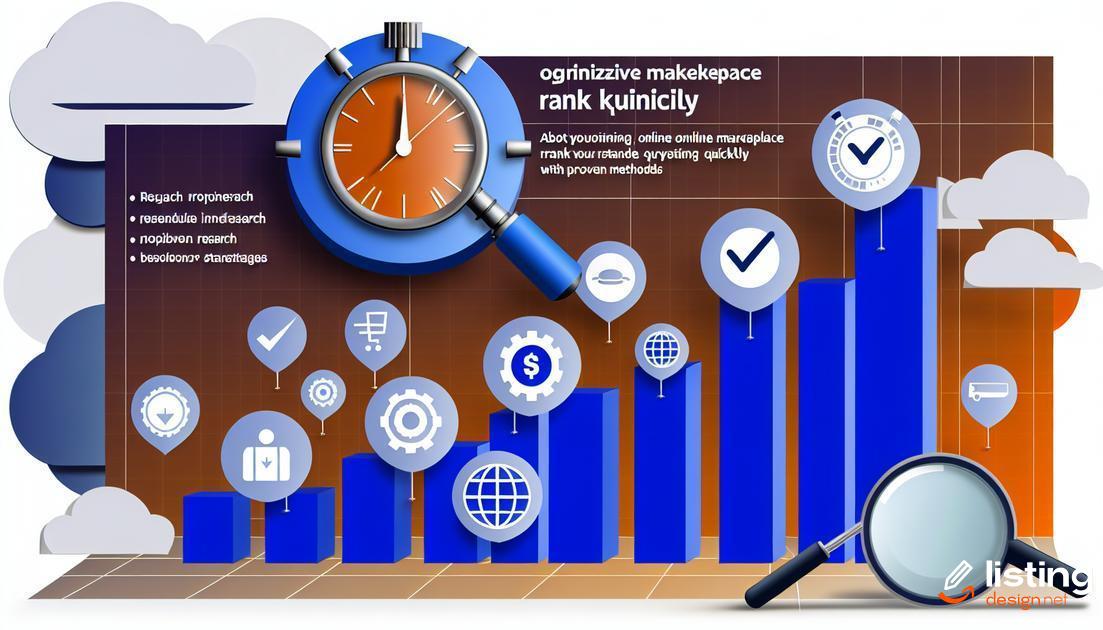To optimize Amazon rank, businesses need to implement effective strategies that increase visibility and sales. Understanding Amazon’s algorithm, selecting relevant keywords, and creating captivating product listings are just a few of the key steps. Let’s delve into the essentials to ensure your products stand out in a competitive marketplace.
Table of Contents
Understanding Amazon’s Ranking Algorithm
Amazon’s A9 Algorithm determines how products rank in search result pages. It is integral for sellers to understand how this algorithm works in order to optimize product listings effectively and improve visibility.
Amazon’s ranking algorithm is influenced by various factors, including:
- Sales Performance: Products with higher sales ranks tend to score better, as Amazon prioritizes bestsellers.
- Text Match Relevancy: The algorithm examines how keywords in the product listing correlate with the search query.
- Price: Competitive pricing can impact the probability of a product being purchased, hence affecting its rank.
- Availability: Items in stock are favored, as Amazon wants to ensure customers can purchase the products they are searching for promptly.
- Customer Reviews and Ratings: Higher ratings and more reviews can boost product credibility, leading to higher rankings.
- Product Listing Completeness: Detailed and comprehensive listings with multiple images, clear descriptions, and all fields filled out are deemed more useful.
By understanding these key factors, sellers can strategically enhance their listings to align with the algorithm’s criteria, thus improving their chances of achieving higher rankings and attracting more customers.
The Importance of Keywords in Amazon SEO

Effective keyword integration is crucial for enhancing your product’s visibility on Amazon. Keywords should be carefully selected and strategically placed within your product listing to ensure maximum exposure. Primary and secondary keywords play different but complementary roles in driving traffic.
Primary Keywords
These are the main search terms that potential customers are likely to use when looking for products similar to yours. They should be included in key areas such as the product title, bullet points, and descriptions. Effective use of primary keywords can significantly enhance your listing’s relevance in search results.
Secondary Keywords
These keywords support the primary ones and help in broadening your product’s search visibility. They can be integrated into different sections of your listing, including the backend search terms, to capture a wider audience. Secondary keywords often target niche markets and long-tail search phrases.
Keyword density and placement also matter. Overstuffing your listing with keywords can lead to penalties, making it essential to maintain a balance. Ensure a natural flow and readability while incorporating essential keywords. Utilizing precise and relevant keywords will aid in aligning your product with appropriate customer searches, thereby increasing the chances of higher ranking and better sales performance on Amazon.
How to Choose the Right Keywords
Choosing the right keywords is crucial for improving your Amazon ranking. Begin by conducting thorough keyword research to identify terms that potential customers are using to search for products. Utilize tools like Amazon’s own search suggestions, Google Keyword Planner, and third-party tools designed for Amazon SEO.
Pay attention to long-tail keywords as they are often less competitive and can drive more targeted traffic to your products. A long-tail keyword might include several words that describe your product in detail, making it easier for customers to find exactly what they are searching for.
Analyze your competitors to understand which keywords they are targeting. This can give you insights into popular keywords in your niche. However, don’t just copy their strategy – use this information to refine and improve your own keyword list.
Periodically update your keyword list based on changes in search trends and customer behavior. This ensures that your products remain relevant and visible to potential buyers.
Optimizing Product Titles for Better Rankings

Focus on Keyword Placement
Integrate primary keywords naturally within the product titles. This includes positioning the most important keywords at the beginning of the title to ensure they capture attention and search algorithms.
Be Descriptive but Concise
Use clear and concise language. While it’s important to be descriptive to provide enough information about the product, avoid keyword stuffing and overly long titles that might be cut off in search results.
Include Essential Product Details
Ensure to add critical product specifics such as brand, model, size, color, and quantity. These details help not only in improving rankings but also in giving potential buyers quick insights into the product.
Highlight Unique Selling Points
Emphasize unique features and benefits of the product within the title. Highlighting USP can make your product stand out amongst competitors and improve click-through rates.
Maintain Readability and Clarity
Avoid using complex words or jargon. Maintain a balance between keyword use and readability to meet the Amazon SEO requirements and enhance user experience.
Use Synonyms and Variations
Where applicable, incorporate synonyms or variations of your primary keywords to capture different search queries and broaden the reach of your product listings.
Crafting Compelling Product Descriptions
When selling on Amazon, product descriptions play a critical role in attracting potential buyers and improving your search rankings. Crafting compelling product descriptions involves striking a balance between informative content and persuasive language.
First, ensure that your product descriptions are clear and concise. Use bullet points to highlight key features and benefits, making it easy for customers to scan through the information. Avoid jargon and overly technical terms that may confuse readers. Use a conversational tone to better connect with your audience.
Highlight Unique Selling Points (USPs)
Identify and include unique selling points that set your product apart from the competition. Focus on features that solve common problems or meet specific needs of your target audience. This can include anything from superior material quality, innovative design, to added functionalities not found in similar products.
Include keywords naturally within your product descriptions. Integrate both primary and secondary keywords seamlessly into the text to enhance discoverability without sounding forced. Make sure the product descriptions remain reader-friendly and avoid keyword stuffing.
Use High-quality Images and Infographics
Pair your product descriptions with high-quality images and infographics to give a visual representation of your product’s features and benefits. This combination can significantly build trust and convert more visitors into buyers.
Lastly, address potential buyer concerns in your descriptions. Identify common questions that customers may have and provide clear and concise answers. This preemptive approach can reassure buyers and reduce the barrier to purchase.
Leveraging Backend Keywords

How to Maximize Backend Keywords
Backend keywords are essential for optimizing Amazon product listings. These hidden keywords aren’t visible to customers but play a crucial role in enhancing product discoverability. Ensure that you fill out the backend keyword fields with relevant terms your target audience might use. Here are some tips for leveraging backend keywords effectively.
Use All Available Space
Amazon provides a limited number of characters for backend keywords. Utilize all the space by including a variety of relevant keywords, synonyms, and alternate spellings. Avoid commas; instead, use spaces to separate the keywords.
Avoid Repetition
Refrain from repeating words already used in other sections of your product listing. Keep backend keywords unique and cohesive, broadening your reach without redundancy.
Include Misspellings
Common misspellings and variations of your product name can capture additional search traffic. Include these in your backend keywords to account for different search patterns.
Consider Keywords in Different Languages
If your product has a global audience, consider including keywords in other languages. This can help capture international traffic, enhancing your product’s visibility across different regions.
By strategically leveraging backend keywords, you can significantly improve your product’s search ranking and overall visibility on Amazon.
Enhancing Product Images and Videos
High-quality images and videos play a crucial role in enticing customers and boosting conversion rates. Ensure your product images comply with Amazon’s guidelines, with clear, high-resolution images that showcase the product from multiple angles.
Utilize Amazon’s Enhanced Brand Content (EBC) or A+ Content to include additional images and videos that provide a comprehensive view of your product. These elements help narrate the product’s story, highlight its unique features, and differentiate it from competitors.
When creating videos, focus on demonstrating the product’s use, benefits, and any features that solve a specific problem. Keep the videos short, engaging, and to the point. It’s vital to include subtitles and captions to accommodate viewing without sound, ensuring a broader audience.
Optimize images and videos for faster loading times. Large files can slow down the loading speed, negatively impacting user experience and conversions. Use appropriate file formats and compress images without sacrificing quality.
Incorporate relevant keywords in the alt text of images and descriptions in videos. This practice helps improve visibility in search results, both on Amazon and search engines like Google.
Finally, regularly refresh your multimedia content. Updated visuals reflect the latest trends and keep your product listings looking fresh and appealing.
Increasing Customer Reviews and Ratings

Customer reviews and ratings play a crucial role in influencing purchasing decisions and bolstering your product’s credibility on Amazon. Encouraging satisfied customers to leave reviews can significantly enhance your product’s visibility and improve conversion rates. Implement strategies like sending follow-up emails post-purchase, offering exceptional customer service, and engaging directly with customers to request honest feedback.
Incorporate a review request button or link within your packaging or product instructions. Additionally, you can use Amazon’s Request a Review feature to streamline the process. Ensure that you comply with Amazon’s guidelines by avoiding incentivized reviews, as these could lead to penalties or account suspension.
Responding to both positive and negative reviews demonstrates that you value customer feedback, which can build trust and loyalty. Address negative reviews constructively, offering solutions or clarifications, which can also show potential buyers that you are committed to customer satisfaction.
Providing outstanding customer service throughout the buying journey increases the likelihood of positive reviews. Ensure timely order fulfillment, accurate product descriptions, and effective communication. Each positive interaction can translate into a glowing review that boosts your Amazon ranking.
Utilizing Amazon Sponsored Ads
Amazon Sponsored Ads can significantly boost the visibility and sales of your products. These ads operate on a pay-per-click (PPC) model, ensuring that you only pay for actual engagement.
Identifying Your Audience
To maximize the effectiveness of your ads, it’s crucial to identify your target audience. By understanding who is most likely to purchase your products, you can tailor your ads to appeal specifically to them.
Setting Up Your Sponsored Ad Campaign
Begin by navigating to the Advertising tab in your Amazon Seller Central account. From there, select ‘Campaign Manager’ and click on ‘Create Campaign’. Choose the type of ad that best suits your needs, such as Sponsored Products, Sponsored Brands, or Sponsored Display.
Keyword Selection
Keywords are integral to the success of your ad campaign. Use Amazon’s search term report to find high-performing keywords relevant to your products. Consider both broad and exact match keywords to cover a wider audience while still targeting specific buyer intents.
Optimizing Bids
Set competitive bids based on Amazon’s suggested bid range for your selected keywords. Monitor your bid performance regularly and adjust them to ensure you are maximizing your ad spend for the best possible returns.
Crafting Compelling Ad Copy
Your ad copy should be clear, concise, and persuasive. Highlight the unique features and benefits of your product, and use a strong call-to-action to encourage clicks. Make sure your ad copy aligns with the keywords to enhance relevance.
Tracking and Adjusting
Continuously monitor the performance of your ads through Amazon’s reporting tools. Pay attention to key metrics such as Click-Through Rate (CTR), Cost-Per-Click (CPC), and Advertising Cost of Sales (ACoS). Make data-driven adjustments to improve ad performance over time.
The Role of Pricing in Amazon Rankings

Amazon’s algorithm heavily considers the pricing of products when determining rankings. A competitive price can significantly boost a product’s visibility on the platform. To remain competitive, sellers must constantly monitor their pricing strategy. This entails analyzing competitors’ prices and ensuring their own prices are aligned or better.
Additionally, Amazon’s Price Parity Clause ensures that the products listed on Amazon aren’t available at lower prices on other platforms. Therefore, maintaining consistent pricing across all sales channels is crucial.
Dynamic pricing strategies can also be advantageous. This involves adjusting prices based on demand, competition, and other market factors. Specialized tools and software can assist sellers in automating these adjustments, ensuring they remain competitive without manual effort.
Furthermore, offering occasional discounts and promotions can entice customers, boost sales, and subsequently improve rankings. However, it’s essential to balance between attractive pricing and maintaining profitability.
Monitoring and Analyzing Your Performance
Once your Amazon store is operational and you’re deploying advanced SEO tactics, it’s crucial to monitor and analyze your performance regularly. This allows you to adapt to changing algorithms and consumer behavior. Employing robust analytics tools will help you track key performance indicators (KPIs) such as sales, click-through rates, and conversion rates.
Implement tracking for specific metrics like organic search performance and paid advertising results. This data will offer insights into which strategies and keywords are producing the best ROI. Moreover, analyzing your competitors can highlight areas for improvement and potential opportunities in your niche.
Regularly review your Amazon Seller Central reports to identify trends and adjust your listings accordingly. Pay attention to customer feedback and reviews as they provide valuable information about your product’s performance and reception. By consistently monitoring and analyzing your performance, you can stay ahead in the competitive Amazon marketplace.
Advanced Strategies to Dominate Amazon SEO

To truly excel in Amazon SEO, it’s essential to employ advanced tactics that go beyond basic optimization. Here, we’ll delve into some powerful strategies.
1. Competitor Analysis
Analyze your top competitors to identify gaps and opportunities. Reviewing their product descriptions, images, and keywords can provide valuable insights to refine your own listings.
2. A/B Testing
A/B testing different elements of your product listings can help you understand what resonates best with your audience. Test variations in product titles, descriptions, and images to optimize for higher conversions.
3. Leverage Amazon A+ Content
Using Amazon’s A+ Content feature can significantly enhance your product detail pages. This allows for rich content, including images, videos, and enhanced text placements, providing a comprehensive view of your product.
4. Refined Keyword Strategy
Move beyond basic keyword research by incorporating long-tail keywords and semantic variations. Utilize tools like Amazon’s Autocomplete and third-party SEO tools to discover hidden keyword opportunities.
5. Product Q&A Section
Encourage the use of the Q&A section on your product pages. This not only provides valuable information to potential buyers but also includes additional keyword-rich content that can boost your rankings.
6. Enhanced Brand Content (EBC)
As a brand-registered seller, take advantage of Enhanced Brand Content. EBC allows for visually enhanced formatting on your listings, helping to improve customer trust and conversion rates.
7. Optimize for Mobile
Ensure your product listings are optimized for mobile devices. This includes having fast-loading images and ensuring that your descriptions and bullet points are easily readable on mobile screens.
8. Utilize External Traffic
Drive external traffic to your Amazon listings through social media, blogs, and email marketing. This can increase product visibility and improve your sales velocity, a key factor in Amazon’s ranking algorithm.
9. Automate Pricing Strategies
Tools and software that automate pricing strategies can help you stay competitive without constant manual adjustments. Dynamic pricing based on competitors and market conditions can keep your products appealing to buyers.
10. Engage with Amazon Influencers
Partnering with Amazon influencers can boost your product’s exposure to a broader audience. Influencer marketing is particularly effective for driving sales and generating authentic reviews.


